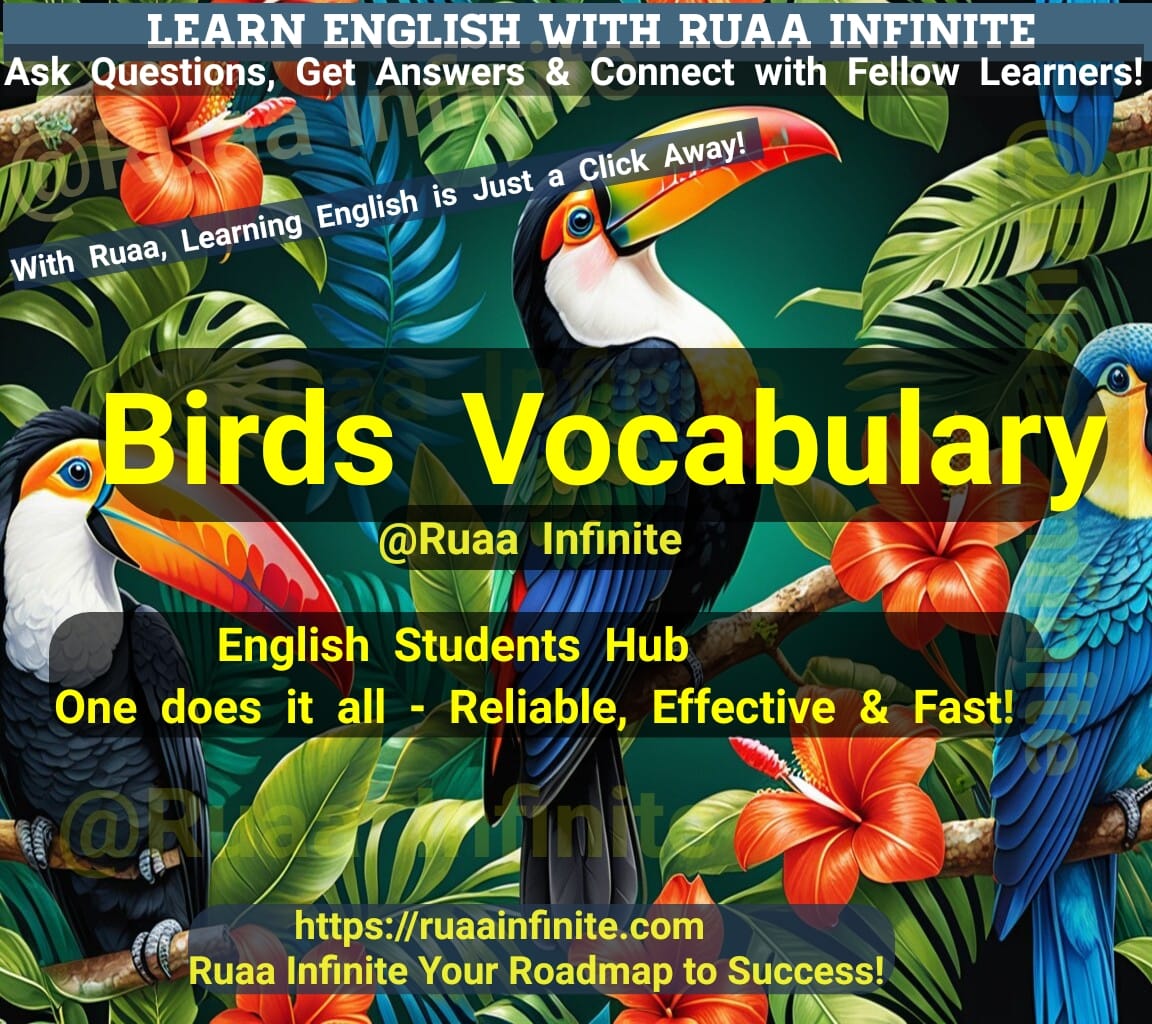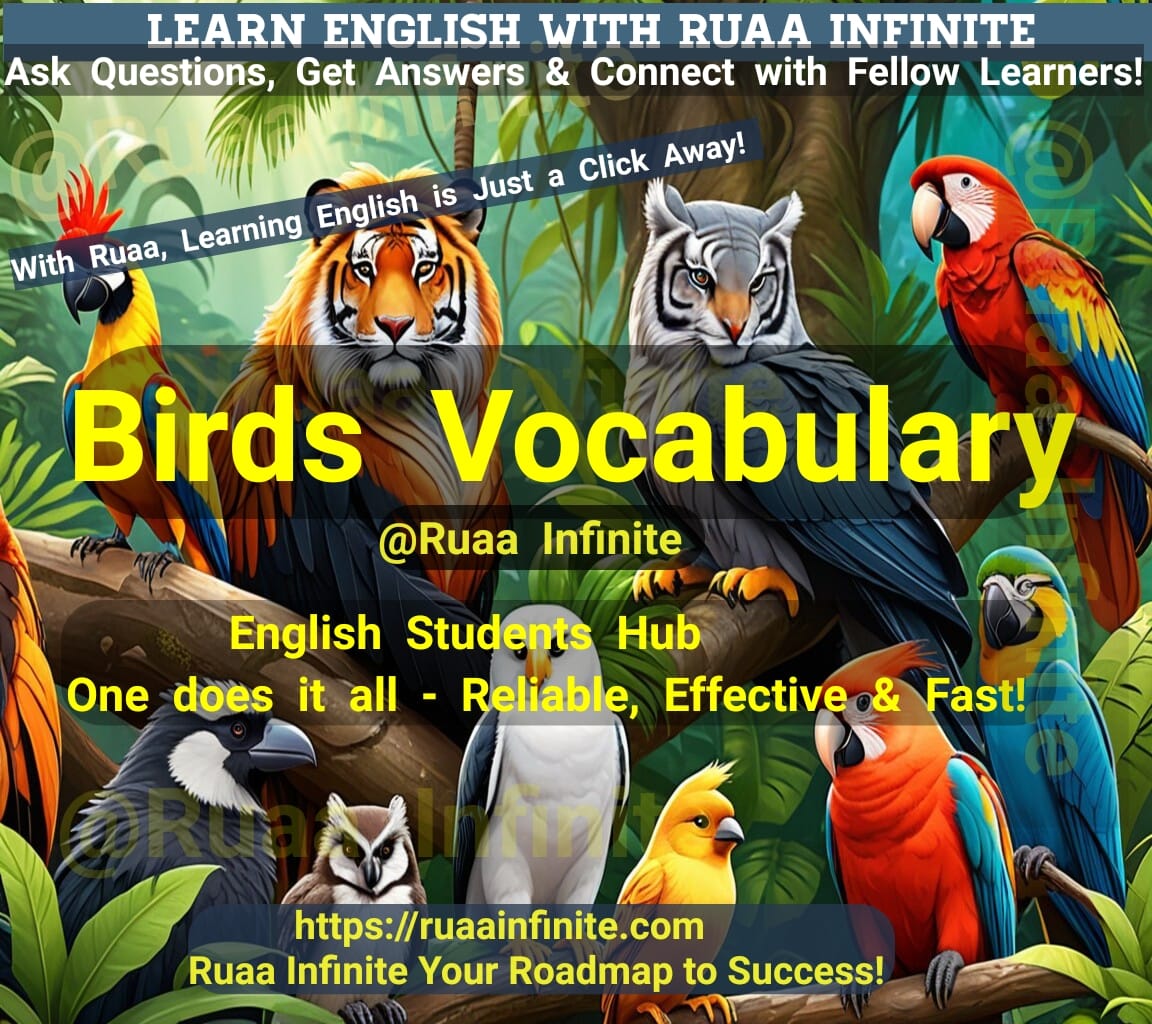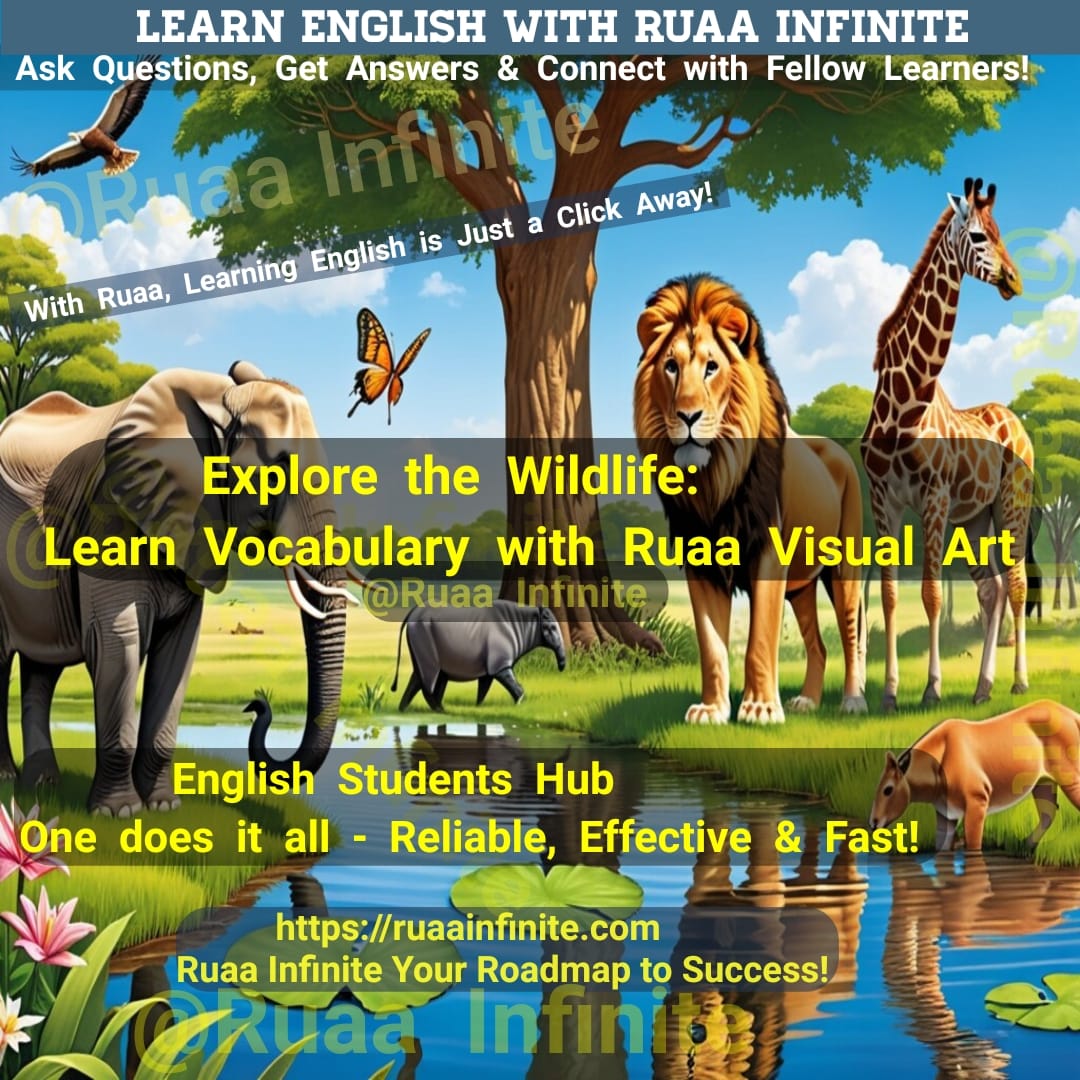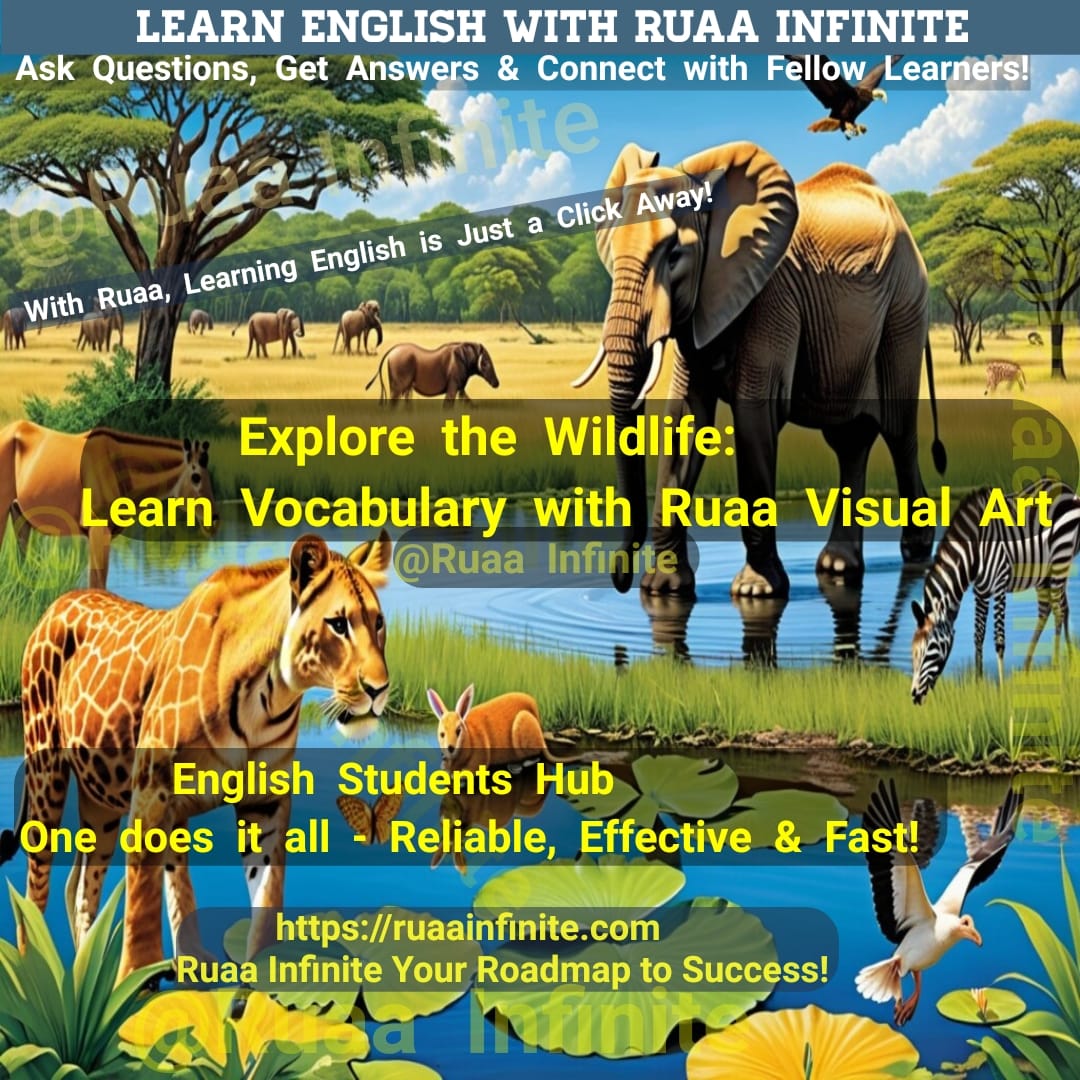Ruaa Visual Art Where Creativity Meets Digital Mastery!
Talking about birds helps you describe different species, behaviors, and habitats. The Birds Vocabulary section will help Owais, Ruaa, and Ruba talk about eagles, sparrows, and other bird species. With Teacher Waleed’s guidance, they’ll learn how to describe birds, their songs, and their environments. Explore more bird-related vocabulary and enjoy birdwatching at ruaainfinite.com!
This comprehensive Birds Vocabulary set helps learners like Owais, Ruaa, and Ruba, with guidance from Teacher Waleed, understand key terms related to birds. This knowledge enhances their ability to appreciate and discuss the diverse world of birds with confidence! For further exploration, visit ruaainfinite.com to expand your language skills and dive deeper into the fascinating world of birds!
Vocabulary with Descriptions and Examples
- Eagle
- A large bird of prey known for its strength and keen vision.
- Examples:
- “Owais spotted an eagle soaring high in the sky.”
- “Ruba learned that eagles build large nests in tall trees.”
- “Teacher Waleed explained that eagles are symbolized as powerful creatures.”
- Sparrow
- A small, active bird often seen in gardens and parks.
- Examples:
- “Ruaa loves to watch sparrows chirping in the garden.”
- “Owais and Ruba found a sparrow building a nest near their house.”
- “Teacher Waleed shared that sparrows are common in urban areas.”
- Penguin
- A flightless bird that lives in cold climates and is known for its waddling walk.
- Examples:
- “Ruaa saw a documentary about penguins living in Antarctica.”
- “Owais visited a zoo and was amazed by the penguins swimming in the water.”
- “Teacher Waleed told them that penguins are excellent swimmers but cannot fly.”
- Parrot
- A colorful bird known for its ability to mimic sounds and words.
- Examples:
- “Ruba’s aunt has a parrot that can say ‘hello’.”
- “Owais was amazed when the parrot repeated his name.”
- “Teacher Waleed explained that parrots are often kept as pets.”
- Owl
- A nocturnal bird of prey known for its distinctive hoot and ability to turn its head around.
- Examples:
- “Ruaa heard an owl hooting in the woods at night.”
- “Owais learned that owls have excellent night vision.”
- “Teacher Waleed taught them that owls symbolize wisdom in many cultures.”
- Pigeon
- A bird commonly found in cities, often seen in parks and on buildings.
- Examples:
- “Ruba was feeding pigeons at the park.”
- “Owais learned that pigeons can be used in racing.”
- “Teacher Waleed said pigeons are known for their homing abilities.”
- Hummingbird
- A tiny bird known for its rapid wing beats and ability to hover in mid-air.
- Examples:
- “Ruaa watched a hummingbird fly around the flowers.”
- “Owais learned that hummingbirds drink nectar from flowers.”
- “Teacher Waleed explained that hummingbirds are among the smallest birds.”
- Flamingo
- A tall bird with bright pink feathers and long legs, often found near water.
- Examples:
- “Ruba saw flamingos in a wildlife sanctuary.”
- “Owais learned that flamingos feed on algae and small crustaceans.”
- “Teacher Waleed shared that flamingos are famous for their unique pink color.”
- Crow
- A highly intelligent, black bird known for its problem-solving skills and adaptability.
- Examples:
- “Ruaa noticed a crow picking up food from the ground.”
- “Owais learned that crows can use tools to gather food.”
- “Teacher Waleed explained that crows are part of the corvid family.”
- Robin
- A small, migratory bird with a red chest, often associated with spring.
- Examples:
- “Owais was happy to see a robin outside his window.”
- “Ruba learned that robins are one of the first birds to appear in spring.”
- “Teacher Waleed said robins are considered harbingers of good fortune.”
- Woodpecker
- A bird known for drumming its beak against trees to find food.
- Examples:
- “Ruaa heard a woodpecker tapping on a nearby tree.”
- “Owais learned that woodpeckers find insects hidden in tree bark.”
- “Teacher Waleed explained that woodpeckers have strong neck muscles to withstand the drumming.”
- Swallow
- A small bird known for its graceful flight and often migrates long distances.
- Examples:
- “Ruba watched swallows swooping over the fields.”
- “Owais learned that swallows migrate to warmer places in the winter.”
- “Teacher Waleed shared that swallows are skilled fliers, catching insects mid-air.”
- Kingfisher
- A small bird with a bright blue or orange plumage, known for its fishing skills.
- Examples:
- “Ruaa was excited to see a kingfisher catch a fish.”
- “Owais learned that kingfishers dive into water to catch prey.”
- “Teacher Waleed explained that kingfishers are excellent at catching small fish.”
- Canary
- A small, yellow bird often kept as a pet for its beautiful singing.
- Examples:
- “Ruba loves the song of her pet canary.”
- “Owais learned that canaries are known for their melodious tunes.”
- “Teacher Waleed said canaries are often kept in cages for their singing ability.”
15. Pelican
- A large water bird known for its distinctive long bill and pouch used for catching fish.
- Examples:
- “Ruaa watched a pelican catch fish near the lake.”
- “Owais learned that pelicans dive from the air to catch their prey.”
- “Teacher Waleed explained that pelicans have a unique way of feeding using their bill pouch.”
16. Bat
- Though not a bird, bats are often grouped with them because of their ability to fly and their nocturnal habits.
- Examples:
- “Ruba saw a bat flying in the dark, catching insects in the night air.”
- “Owais learned that bats are the only mammals capable of sustained flight.”
- “Teacher Waleed explained that bats are important for controlling insect populations.”
17. Vulture
- A large bird of prey known for scavenging on dead animals.
- Examples:
- “Ruaa spotted a vulture circling high above the savannah.”
- “Owais read that vultures play a crucial role in cleaning the environment by eating carcasses.”
- “Teacher Waleed mentioned that vultures are often seen in hot, dry climates.”
18. Kangaroo
- Though not a bird, it’s often included in wildlife vocabulary; it’s known for hopping and living in Australia.
- Examples:
- “Ruba was excited to see kangaroos at the zoo.”
- “Owais learned that kangaroos are herbivores and mainly eat grass.”
- “Teacher Waleed explained that kangaroos have powerful hind legs for jumping.”
18. Swallow
- A small migratory bird known for its swift flight and forked tail.
- Examples:
- “Ruaa smiled as she watched a swallow darting through the air.”
- “Owais noticed swallows building nests on the eaves of buildings.”
- “Teacher Waleed shared that swallows migrate long distances between seasons.”
19. Albatross
- A large seabird with long wingspans, known for flying over vast ocean distances.
- Examples:
- “Ruba was fascinated by the albatross gliding smoothly over the ocean.”
- “Owais learned that albatrosses can stay in the air for hours without flapping their wings.”
- “Teacher Waleed explained that the albatross is often seen as a symbol of endurance.”
20. Dove
- A gentle, often white bird, commonly associated with peace.
- Examples:
- Ruaa released a dove at the wedding, symbolizing peace and love.
- Owais admired the dove’s soft feathers and graceful flight.
- Teacher Waleed mentioned that doves are often used in religious ceremonies.
21. Ostrich
- The largest living bird, known for its inability to fly but its speed on land.
- Examples:
- “Ruaa was fascinated when she saw an ostrich running at incredible speeds.”
- “Owais learned that ostriches can outrun most predators.”
- “Teacher Waleed told the class that ostriches live in Africa and Asia.”
22. Eagle
- A large, powerful bird of prey with keen eyesight, often seen as a symbol of freedom.
- Examples:
- “Ruba was in awe when she saw an eagle soaring high in the sky.”
- “Owais learned that eagles have extraordinary vision and can spot prey from miles away.”
- “Teacher Waleed explained that eagles often build their nests in tall trees or cliffs.”
23.Seagull
- A common coastal bird known for its loud calls and scavenging habits.
- Examples:
- “Ruaa watched a seagull dive into the water to catch a fish.”
- “Owais noticed a seagull stealing food from tourists at the beach.”
- “Teacher Waleed explained that seagulls are known for being opportunistic feeders.”
24. Canary
- A small, songbird known for its cheerful singing, often kept as a pet.
- Examples:
- “Ruba loved listening to the canary sing early in the morning.”
- “Owais learned that canaries are often bred for their beautiful songs.”
- “Teacher Waleed explained that canaries are originally from the Canary Islands.”
25. Peafowl
- The term for both male and female peacocks, with the male known for its extravagant tail feathers.
- Examples:
- “Ruba admired the peafowl as it displayed its colorful feathers.”
- “Owais learned that only male peafowls have the large, colorful tail feathers.”
- “Teacher Waleed explained that peafowls are native to South Asia.”
26. Puffin
- A small seabird with a colorful beak, often associated with northern coastal regions.
- Examples:
- “Ruaa saw puffins nesting on the cliffs during her visit to Iceland.”
- “Owais learned that puffins are excellent swimmers and divers.”
- “Teacher Waleed explained that puffins are often called the ‘clowns of the sea’ due to their unique appearance.”
27. Heron
- A tall, long-legged bird often found near water, known for its graceful hunting technique.
- Examples:
- “Ruba watched a heron standing perfectly still in the shallow water, waiting for fish.”
- “Owais learned that herons have long beaks and legs to help them catch fish.”
- “Teacher Waleed explained that herons are usually solitary birds.”.
28. Gull
- A common coastal bird often seen scavenging for food near beaches.
- Examples:
- “Ruba watched a gull dive down to snatch a snack from the shore.”
- “Owais noticed a gull following the boat for food.”
- “Teacher Waleed explained that gulls are opportunistic feeders.”
29. Titmouse
- A small, plump bird with a crest on its head, found in forests and gardens.
- Examples:
- “Ruaa spotted a titmouse hopping around the garden looking for seeds.”
- “Owais learned that titmice are agile and good at climbing trees.”
- “Teacher Waleed explained that titmice are known for their cheerful calls.”
30. Wren
- A small, active bird known for its loud song despite its size.
- Examples:
- “Ruba was delighted by the wren’s cheerful song coming from the bushes.”
- “Owais learned that wrens build intricate nests in hidden places.”
- “Teacher Waleed explained that wrens are very territorial.”
31. Kookaburra
- A bird native to Australia, known for its distinctive, laughing call.
- Examples:
- “Ruaa laughed when she heard the kookaburra’s unique laughter echoing through the trees.”
- “Owais learned that kookaburras often sit on branches, looking for small prey.”
- “Teacher Waleed explained that kookaburras are related to kingfishers.”
32. Crane
- A tall, elegant bird known for its graceful movements and complex mating dances.
- Examples:
- “Ruba was fascinated by the crane’s dance during the mating season.”
- “Owais learned that cranes are often seen in wetlands and grasslands.”
- “Teacher Waleed explained that cranes are a symbol of longevity in many cultures.”
33. Tit
- A small, energetic bird that is often seen flitting about in gardens and woods.
- Examples:
- “Ruaa watched a tit darting from tree to tree in search of food.”
- “Owais learned that tits are social birds that often live in flocks.”
- “Teacher Waleed explained that tits are found in a wide range of habitats, from forests to gardens.”
34. Myna
- A bird known for its ability to mimic human speech and sounds.
- Examples:
- “Ruba laughed when the myna bird repeated everything she said.”
- “Owais learned that mynas are often kept as pets for their speaking ability.”
- “Teacher Waleed explained that mynas are native to Asia but have been introduced to other parts of the world.”
35. Quail
- A small, ground-dwelling bird with a distinctive plume on its head.
- Examples:
- “Ruaa spotted a quail running through the grass in the field.”
- “Owais learned that quails are often found in fields and forests, where they nest on the ground.”
- “Teacher Waleed explained that quail eggs are considered a delicacy in some countries.”
36. Jackdaw
- A small black bird closely related to crows, known for its playful behavior and intelligence.
- Examples:
- “Ruaa watched a jackdaw hop around looking for shiny objects.”
- “Owais learned that jackdaws are highly social birds and often form large flocks.”
- “Teacher Waleed explained that jackdaws are curious birds, known for their ability to use tools.”
37. Nightingale
- A small songbird known for its beautiful and complex song, often heard at night.
- Examples:
- “Ruba was enchanted by the nightingale’s song echoing through the evening air.”
- “Owais learned that nightingales sing to communicate with each other and attract mates.”
- “Teacher Waleed explained that the nightingale is a symbol of poetic inspiration in many cultures.”
38. Tern
- A seabird known for its graceful flight and often found along coasts and beaches.
- Examples:
- “Ruaa watched a tern dive into the water to catch a fish.”
- “Owais learned that terns are often seen flying in groups over coastal waters.”
- “Teacher Waleed explained that terns are known for their long migrations.”
39. Sandpiper
- A small wading bird often found on sandy shores, known for its rapid movements.
- Examples:
- “Ruba observed a sandpiper darting across the beach, searching for food.”
- “Owais learned that sandpipers are often seen along shorelines, hunting for small invertebrates.”
- “Teacher Waleed explained that sandpipers have adapted to life near the water’s edge.”
40. Vireo
- A small, greenish bird found in North America, known for its pleasant song.
- Examples:
- “Ruaa was delighted to hear the vireo’s song from the trees.”
- “Owais learned that vireos are insect-eating birds that are often seen in woodlands.”
- “Teacher Waleed explained that vireos are known for their energetic behavior and small size.”
41. Bald Eagle
- A large bird of prey, symbolizing the United States, known for its white head and tail.
- Examples:
- “Ruba watched a bald eagle soaring high above the forest.”
- “Owais learned that bald eagles are powerful predators and can spot prey from miles away.”
- “Teacher Waleed explained that the bald eagle is the national bird of the United States.”
42. Zebra Dove
- A small, gray dove known for its zebra-like striped pattern on its neck.
- Examples:
- “Ruaa admired the zebra dove as it perched on the fence.”
- “Owais learned that zebra doves are often found in Southeast Asia.”
- “Teacher Waleed explained that zebra doves are known for their gentle nature.”
43. Starling
- A medium-sized passerine bird known for its iridescent plumage and ability to mimic sounds.
- Examples:
- “Ruba marveled at the starling’s beautiful feathers as it flew past her.”
- “Owais learned that starlings are known for their impressive murmuration displays.”
- “Teacher Waleed explained that starlings are social birds that often travel in flocks.”
44. Goldfinch
- A small songbird with bright yellow feathers and a distinctive red face, often found in gardens.
- Examples:
- “Ruaa spotted a goldfinch perched on a sunflower in her backyard.”
- “Owais learned that goldfinches love to feed on thistle seeds.”
- “Teacher Waleed explained that goldfinches are known for their cheerful song.”
45. Bowerbird
- A bird famous for building intricate nests and decorating them with colorful objects to attract mates.
- Examples:
- “Ruaa was fascinated by the bowerbird’s creative nest-building process.”
- “Owais learned that bowerbirds collect items like plastic and flowers to decorate their nests.”
- “Teacher Waleed explained that bowerbirds’ nests are among the most elaborate in the bird world.”
46. Pelican
- A large waterbird with a distinctive long bill and a large throat pouch used for catching fish.
- Examples:
- “Ruba watched a pelican scoop up fish with its large bill.”
- “Owais learned that pelicans are skilled at diving and catching fish from the water.”
- “Teacher Waleed explained that pelicans are often seen in coastal areas, hunting for food.”
47. Lark
- A small bird known for its beautiful song, often heard while it is in flight.
- Examples:
- “Ruaa heard a lark singing high in the sky during her morning walk.”
- “Owais learned that larks are most active in the early morning hours.”
- “Teacher Waleed explained that larks are symbols of joy and freedom in many cultures.”
48. Cuckoo
- A bird famous for laying its eggs in the nests of other birds, often associated with spring.
- Examples:
- “Ruba heard the cuckoo’s distinctive call echoing through the forest.”
- “Owais learned that cuckoos don’t build their own nests but instead use those of other birds.”
- “Teacher Waleed explained that the cuckoo’s call is a hallmark sound of spring in many parts of the world.”
49. Noddy
- A small seabird that belongs to the tern family, known for its dark plumage and distinctive white cap.
- Examples:
- “Ruba was intrigued by the noddy’s sleek appearance as it flew over the water.”
- “Owais learned that noddies are often found in tropical and subtropical regions.”
- “Teacher Waleed explained that noddies are very social birds and often breed in large colonies.
50. Osprey
- A large bird of prey with a white head and dark eyes, known for hunting fish.
- Examples:
- “Ruaa watched in awe as the osprey swooped down to catch a fish from the lake.”
- “Owais learned that ospreys are highly skilled hunters and can dive from great heights.”
- “Teacher Waleed explained that ospreys are found near bodies of water all over the world.”
51. Condor
- A large vulture found in the Americas, known for its impressive wingspan.
- Examples:
- “Ruba marveled at the condor soaring high in the mountains, its wings stretched wide.”
- “Owais learned that condors have one of the largest wingspans of any bird.”
- “Teacher Waleed explained that condors are scavengers, feeding on the remains of dead animals.”
52. Parakeet
- A small, colorful bird often kept as a pet, known for its cheerful nature and ability to mimic sounds.
- Examples:
- “Ruaa giggled as her parakeet repeated everything she said.”
- “Owais learned that parakeets are social birds that enjoy interacting with their owners.”
- “Teacher Waleed explained that parakeets are often found in flocks in the wild.”
53. Wagtail
- A small, lively bird known for its characteristic habit of wagging its tail.
- Examples:
- “Ruba was delighted to see a wagtail hopping around the garden, its tail constantly moving.”
- “Owais learned that wagtails are often found near water, where they catch insects.”
- “Teacher Waleed explained that wagtails are named for their unique tail movements.”
54. Raven
- A large, intelligent bird from the crow family, known for its glossy black feathers and deep call.
- Examples:
- “Ruaa spotted a raven perched on a tree, its feathers shining in the sunlight.”
- “Owais learned that ravens are one of the most intelligent bird species.”
- “Teacher Waleed explained that ravens have been symbols of mystery and knowledge in many cultures.”
55. Falcon
• A bird of prey known for its hunting prowess and speed.
• Examples:
- Ruba watched in awe as the falcon soared through the sky, its sharp eyes scanning the ground below.
- Owais learned that falcons use their powerful beaks and talons to catch their prey mid-flight.
- Teacher Waleed explained that falcons are often considered symbols of strength and precision.
56. Peregrine Falcon
• The fastest bird in the world, known for its incredible speed during hunting dives.
• Examples:
- Ruba was fascinated by the peregrine falcon’s speed as it dove toward its target.
- Owais learned that peregrine falcons can dive at speeds exceeding 200 miles per hour.
- Teacher Waleed shared that peregrine falcons are often used in falconry due to their remarkable hunting skills.
57. Kestrel
• A small falcon with a unique hovering flight pattern, often found in open fields.
• Examples:
- Ruba spotted a kestrel hovering above the field, patiently waiting for its next meal.
- Owais learned that kestrels have excellent eyesight, allowing them to catch insects and small rodents while hovering.
- Teacher Waleed explained that kestrels are among the smallest of the falcon species.
58. Merlin
• A small and fast falcon known for its agility and hunting skills in forests and open spaces.
• Examples:
- Ruaa noticed a Merlin darting between the trees as it hunted for prey.
- Owais learned that Merlins are known for their swift movements, which help them catch small birds.
- Teacher Waleed explained that despite their small size, Merlins are fierce hunters.
59. Hawk
• A bird of prey that shares many similarities with falcons but is typically larger and less agile.
• Examples:
- Ruba watched a hawk glide through the air, searching for small mammals below.
- Owais learned that hawks rely more on their keen vision than speed to hunt.
- Teacher Waleed pointed out that while hawks and falcons both belong to the raptor family, their hunting techniques differ.
60. Falconry
• The practice of training falcons to hunt, dating back thousands of years.
• Examples:
- Ruaa was intrigued when Teacher Waleed showed her how falconers train falcons for hunting.
- Owais hoped to try falconry one day and train a falcon to hunt.
- Ruba was impressed by the skill required in falconry, where the falcon is both a pet and a hunting companion.
61. Great Horned Owl
- A large owl with distinctive tufts of feathers on its head, known for its hooting call.
- Examples:
- “Ruaa listened to the hoot of a great horned owl echoing through the night.”
- “Owais learned that great horned owls are excellent hunters, feeding on small mammals and birds.”
- “Teacher Waleed explained that great horned owls are one of the most widespread owl species in North America.”
62. Shorebird
- A group of wading birds typically found along shorelines, known for their foraging behavior.
- Examples:
- “Ruba observed several shorebirds running along the beach, searching for food.”
- “Owais learned that shorebirds are skilled at finding small invertebrates along the water’s edge.”
- “Teacher Waleed explained that shorebirds are often migratory and travel long distances.”
63. Roseate Spoonbill
- A striking wading bird with a long, spoon-shaped bill and pink plumage.
- Examples:
- “Ruba was amazed by the beauty of the roseate spoonbill as it searched for food in the marsh.”
- “Owais learned that roseate spoonbills use their bill to sift through mud for small fish and crustaceans.”
- “Teacher Waleed explained that roseate spoonbills are often found in wetlands across the Americas.”
64. Nighthawk
• A nocturnal bird known for its erratic flight patterns and distinctive call heard at night.
• Examples:
- Ruaa was excited to hear the nighthawk’s distinctive call echoing in the quiet night.
- Owais noticed that the nighthawk often flies in a zigzag pattern as it hunts for insects at dusk.
- Teacher Waleed shared that nighthawks are insectivores, feeding on moths and beetles during the night.
65. Bat Hawk
• A bird of prey known for its nocturnal hunting habits, often hunting bats in flight.
• Examples:
- Ruaa was amazed to learn that the bat hawk hunts at night, catching bats mid-air with its sharp talons.
- Owais observed the bat hawk’s impressive flight skills as it circled high above.
- Teacher Waleed shared that bat hawks are specially adapted for hunting at night, using their excellent vision and speed.
Note:
Murmuration: refers to the breathtaking phenomenon where large flocks of birds, particularly starlings, fly together in a coordinated and dynamic pattern. These patterns appear as swirling, flowing shapes in the sky, almost like a living cloud. The term comes from the murmuring sound their wings make as they fly closely together. This behavior is thought to help protect against predators, share warmth, and communicate among the flock.
Starlings: (a type of bird) are known for their murmuration displays—a stunning natural phenomenon where large flocks of starlings fly together in intricate, coordinated patterns, creating mesmerizing shapes in the sky. This behavior is often observed at dusk as the birds gather to roost.
Ready to Take the Next Step?
If you enjoyed the free sample lesson and are eager to dive deeper, our full Essential Survival English course is just a click away! Purchase now to enjoy curated lessons and start your journey toward mastering English for any situation with confidence!
Buy the Essential Survival English Course Now!
Don’t miss out on the opportunity to elevate your English skills in a supportive community. Join us today and start your exciting journey with Ruaa Infinite!
📚🌍 Over 1500 daily vocabulary words!
📢 Join us & spread the word!
✅ Thank you for your support! 💙
✨ Join the English Learning Revolution & Unlock New Opportunities with Ruaa Infinite!
👉 Explore here: https://ruaainfinite.com/category/english-students-hub/
Let’s create a new world where communication skills are EASY! Whether you’re starting from scratch or aiming for fluency, Ruaa Infinite lessons are simple, effective, and FUN!
🔗 EXPLORE MORE:
• Shop courses & books to take your English to the next level: https://ruaainfinite.com/shop
• Discover inspiring content on Pinterest: https://www.pinterest.com/ruaainfnite/pins/
• Watch more engaging videos on YouTube: https://www.youtube.com/@RuaaInfinite
• Find our latest book releases:
👉 https://ruaainfinite.com/product-category/books/
👉 https://www.lulu.com/search?contributor=Ruaa+Infinite
👉 https://ruaainfnite.gumroad.com/
💬 Contact Us:
🌐 Website: ruaainfinite.com/contact
📧 Email: ruaainfnite@gmail.com
✨ Visit ruaainfinite.com to elevate your journey and take every step with confidence! 🚀
🔥Ruaa Digital Artwork brings nature and creativity to life with stunning digital visuals, perfect for art enthusiasts and learners alike! Make every step a success and boost your confidence. Visit the link above to get started! 🌟
Have a nice day ahead!
All the best,
Teacher Waleed Rizq






